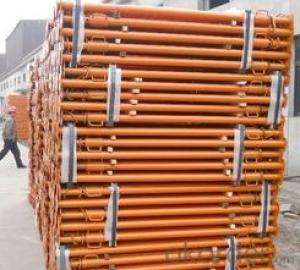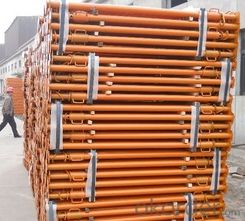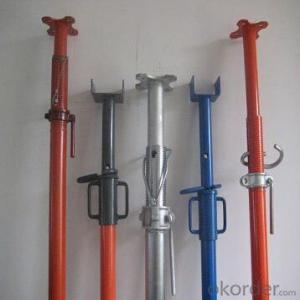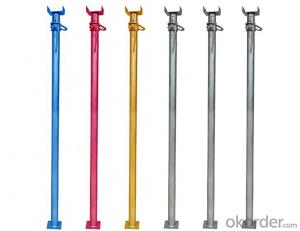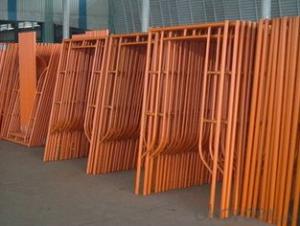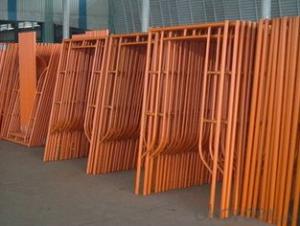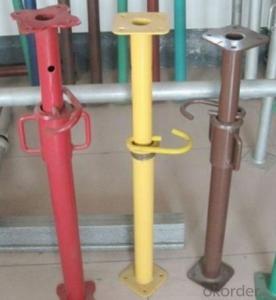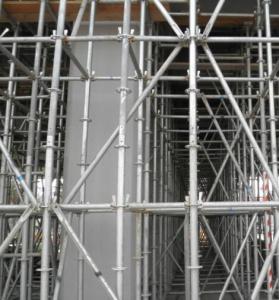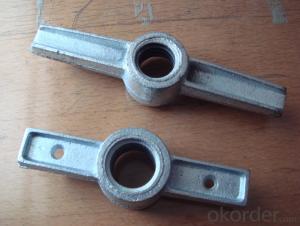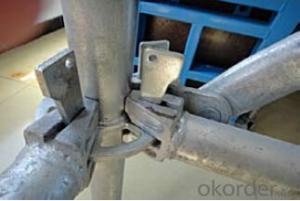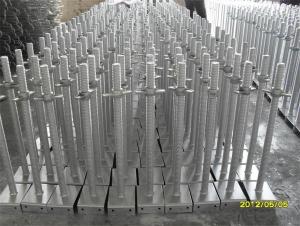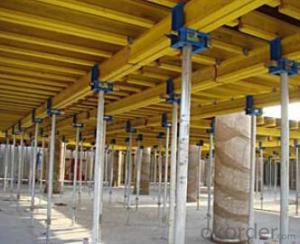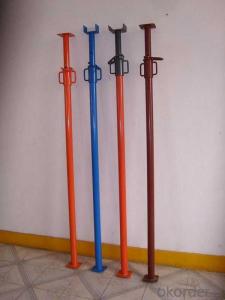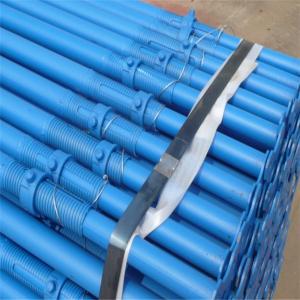Scaffolding System and Accessories
- Loading Port:
- China Main Port
- Payment Terms:
- TT OR LC
- Min Order Qty:
- -
- Supply Capability:
- -
OKorder Service Pledge
OKorder Financial Service
You Might Also Like
Quick Details
| Model Number: | |||||
| Name: | Catagory: | Type: | |||
| Material: | Size: | Surface: | |||
| Technology: | Component: | Application: | |||
| Manufacturer: |
Packaging & Delivery
| Packaging Detail: | as the requirment of clients |
| Delivery Detail: | 20days |
Specifications
RingLock Scaffold System & Accessory
Material: Steel Q235/Q345
Surface:Galvanzied/Painted
Manufacturer, OEM
ISO, BS1139
Name: Q235/Q345 Galvanzied RingLock Scaffold System and Accessories for Construction
Category: Scaffolding system
Material: Steel (Q235/Q345)
Size: D48.3*3.25MM
Surface: Electro Galvanized/Self Color/Painted/HDG
Component: Standard, Ledger, Angle Iron ledger, Diagonal, Bracket, Holder, Support, Edge Banding, Board Holder, base jack, U head Jack, etc.
Application: Slab support,staircase,stage platforms,bridge support,mobile tower etc.
Advantage: Durable, Stable, Skid-proof, Antirust, Easy to assemble & Dismantle
OEM service is available
Items or goods can be manufactured according to your standards
- Q: Can steel props be used in the construction of water treatment plants or reservoirs?
- Yes, steel props can be used in the construction of water treatment plants or reservoirs. Steel props are commonly used in construction projects to provide temporary support to structures, and they can be utilized in the construction of water treatment plants or reservoirs to support temporary structures, such as formwork or scaffolding. However, it is important to consider the specific requirements and conditions of the project, as well as any regulations or guidelines pertaining to the use of steel props in water-related structures.
- Q: Can steel props be used for supporting temporary storage structures or warehouses?
- Yes, steel props can be used for supporting temporary storage structures or warehouses. Steel props, also known as adjustable steel props or scaffolding props, are commonly used in the construction industry to provide temporary support to structures. They are made of high-quality steel and have the ability to withstand heavy loads. Steel props are adjustable in height, making them suitable for various applications, including supporting temporary storage structures or warehouses. They are easy to set up and dismantle, providing a flexible and efficient solution for temporary storage needs. Additionally, steel props offer stability and durability, ensuring the safety and security of the storage structure or warehouse.
- Q: Can steel props be used for supporting temporary fencing?
- Yes, steel props can be used for supporting temporary fencing. Steel props are sturdy and durable, making them suitable for providing stability and support to temporary fencing structures.
- Q: How do steel props compare to concrete slabs?
- Steel props and concrete slabs are two different components used in construction projects. Steel props, also known as steel supports or shoring systems, are temporary structural elements used to support loads during construction or renovation. They are adjustable, versatile, and can be easily installed and removed. On the other hand, concrete slabs are horizontal structural elements that form the base of a building or floor. They provide a solid foundation and can be reinforced with steel bars for added strength. Concrete slabs are permanent and require careful planning, formwork, and curing time. When comparing steel props to concrete slabs, it is essential to understand their different purposes. Steel props are primarily used for temporary support during construction activities, providing flexibility and adaptability. Concrete slabs, on the other hand, provide a permanent structural base for buildings or floors. Both steel props and concrete slabs play crucial roles in construction projects, but their functions are distinct. While steel props offer temporary support and flexibility, concrete slabs provide a durable and long-lasting foundation. Their usage depends on the specific requirements of the project and should be chosen accordingly.
- Q: What are the common signs of wear and tear in steel props?
- The signs of wear and tear in steel props can differ based on their specific use and conditions. However, there are some common indications to look out for: 1. Surface corrosion: Moisture and environmental conditions can cause rust spots or discoloration on the steel surface. 2. Deformation: Heavy loads, improper storage, or accidental impacts can lead to bending, warping, or buckling of the steel structure. 3. Cracks or fractures: Excessive weight or prolonged use may result in cracks or fractures on the main structural elements or at the joints. 4. Loose or damaged nuts and bolts: The fasteners connecting various components can become loose, damaged, or stripped, affecting stability and safety. 5. Increased movement or instability: Wear and tear can cause wobbling or shaking during use, compromising the structural integrity. 6. Reduced load-bearing capacity: Material fatigue, corrosion, or other forms of damage can decrease the prop's ability to support the intended load or cause visible signs of stress. 7. Deterioration of protective coatings: Peeling, cracking, or chipping of the protective coatings may occur over time. Regular inspections are crucial to ensure the continued safety and performance of steel props. If any of these signs are noticed, appropriate measures such as repairs, replacements, or strengthening should be taken.
- Q: What is the weight of a standard steel prop?
- The weight of a standard steel prop may differ based on its specific size and design. On average, a typical standard steel prop weighs around 20 to 30 pounds (9 to 14 kilograms). It is crucial to acknowledge that this weight range is merely an approximation, and the actual weight may vary depending on factors like the prop's length, thickness, and load-bearing capacity. Moreover, various manufacturers may have their own weight variations for their steel props.
- Q: How do steel props compare to jack posts in terms of performance?
- Temporary supports in construction and renovation projects often include steel props and jack posts. While their purpose is the same, providing temporary structural support, they have performance differences. Steel props, also known as steel shore posts or acrow props, are adjustable steel tubes with a threaded end capable of extension or retraction to the desired height. Typically made from high-quality steel, they are designed to withstand heavy loads. Known for their strength, stability, and versatility, steel props are useful in various applications such as supporting walls, beams, and floors during construction or renovation. They are easy to install, require minimal maintenance, and can be adjusted to fit different heights and angles. Steel props are particularly preferred when dealing with larger and more complex structures due to their high load-bearing capacity. On the other hand, jack posts, also known as screw jacks or adjustable basement support poles, are more commonly used in residential applications, especially for temporary support in basements or crawl spaces. Comprising a steel post with a threaded rod, they can be adjusted by turning a nut at the top. Jack posts are generally lighter and less durable than steel props. They are designed for supporting lighter loads and are not suitable for heavy-duty applications. However, jack posts are more affordable and easier to transport and install compared to steel props. Regarding performance, steel props surpass jack posts in terms of load-bearing capacity and strength. They are capable of supporting heavy loads, making them more suitable for larger and more complex structures. Steel props offer greater stability and can be adjusted to fit various heights and angles, making them more versatile in different construction scenarios. Conversely, jack posts are more suitable for lighter loads and residential applications, where their affordability and ease of installation are advantageous. In conclusion, steel props and jack posts both serve as temporary supports but differ in performance. Steel props are stronger, more stable, and versatile, making them suitable for heavy-duty and complex construction projects. Jack posts, however, are more affordable and easier to install, making them preferable for lighter loads and residential applications. The choice between the two depends on the specific project requirements and load-bearing needs.
- Q: Can steel props be used in the construction of power plants or refineries?
- Yes, steel props can be used in the construction of power plants or refineries. Steel props are commonly used in construction projects to provide temporary support to structures or equipment during the construction phase. Power plants and refineries are large-scale industrial projects that require the installation of heavy equipment and structures, and steel props can be used to support these components during construction. Steel props are preferred in such projects due to their high strength and load-bearing capacity. They are adjustable and can be easily extended or shortened to accommodate the specific requirements of the construction site. The steel props are typically used to support beams, columns, or temporary structures until permanent supports are put in place. Additionally, steel props are durable and can withstand the harsh conditions often encountered in power plants and refineries, such as high temperatures, corrosive chemicals, and intense vibrations. They are also fire-resistant, making them suitable for use in areas where fire safety is a concern. However, it is important to note that steel props are temporary supports and are not intended for long-term use. Once the construction is completed, permanent support systems or structures are installed to ensure the stability and safety of the power plant or refinery.
- Q: Can steel props be used for supporting temporary transport infrastructure?
- Support for temporary transport infrastructure can be provided by steel props. These props, also known as adjustable steel props or steel shore props, are commonly used in construction projects to support temporary structures like scaffolding, formwork, and shoring systems. They are versatile and can be easily adjusted to different heights, making them suitable for various applications in the construction industry. When it comes to supporting temporary transport infrastructure, steel props can be utilized to offer temporary support for bridges, tunnels, and other transportation structures during construction or maintenance activities. They assist in distributing the load and ensuring stability in the temporary structure, guaranteeing the safety of workers and the smooth flow of traffic. Made of high-quality steel, steel props possess strength, durability, and load-bearing capacity. They can withstand heavy loads and provide reliable support for temporary transport infrastructure. Furthermore, their adjustable nature allows for flexibility in height adjustments, enabling them to adapt to different project requirements. Moreover, steel props are relatively simple to install and dismantle, making them convenient for temporary applications. They can be quickly assembled and adjusted to the required height, saving time and effort during the construction process. Once the temporary transport infrastructure is no longer needed, the steel props can be easily removed and reused for future projects. In conclusion, steel props are an effective choice for supporting temporary transport infrastructure. Their strength, adjustability, and ease of installation make them a reliable option for providing temporary support to bridges, tunnels, and other transportation structures during construction or maintenance activities.
- Q: What are the different weight classes available for steel props?
- The weight classes available for steel props can vary depending on the specific manufacturer and their product offerings. However, some common weight classes for steel props include: 1. Light Duty: These props are designed for lighter loads and typically have a maximum load capacity of up to 10 kN (kilonewtons). They are suitable for smaller construction projects or temporary support needs. 2. Medium Duty: This weight class includes props with a maximum load capacity ranging from 10 kN to 20 kN. They are more robust than light duty props and can handle heavier loads. Medium-duty props are commonly used in residential and commercial construction projects. 3. Heavy Duty: These props are built to support significantly heavier loads and have a maximum load capacity of 20 kN or higher. They are commonly used in large-scale construction projects such as high-rise buildings or bridges. Heavy-duty props provide additional stability and strength to ensure the safety of the structure. It is important to note that weight classes may vary between manufacturers, and it is essential to consult the specific product specifications to determine the appropriate weight class for your construction needs. Additionally, it is always recommended to consult with a structural engineer or construction professional to ensure the correct selection and usage of steel props for any given project.
Send your message to us
Scaffolding System and Accessories
- Loading Port:
- China Main Port
- Payment Terms:
- TT OR LC
- Min Order Qty:
- -
- Supply Capability:
- -
OKorder Service Pledge
OKorder Financial Service
Similar products
Hot products
Hot Searches
Related keywords
